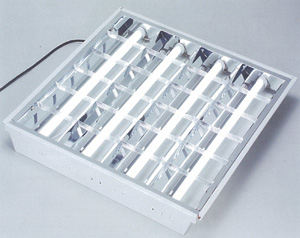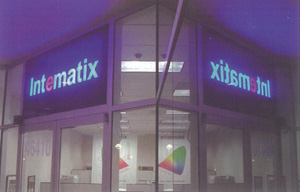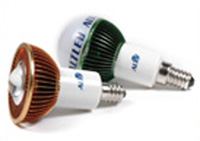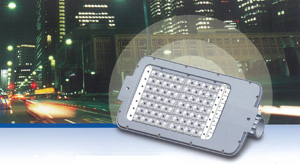Taiwan's LED Lighting Makers Offer Plug-in Products to Up Popularity
2011/01/11 | By Ken LiuUser-friendliness usually determines if a new product can penetrate a market dominated by older items targeted for replacement. LED (light emitting diode) lighting manufacturers have been eager to build such merit into LED products to better persuade end users to adopt the new, greener light source. The makers in Taiwan have gone one step further by also paring prices of products to realistically compete against traditional lights.
Randy Cheng, general manager of the Guangdong-headquartered Neo-Neon Holdings Corp.'s Taiwan branch, stresses its “retrofittable” strategy, or making LED lights simple plug-ins, meaning consumers can buy LED lights to conveniently replace broken light or fluorescent bulbs without extra work. Convenience helps boost acceptance, says Cheng. The company's retrofittable lamps include MR, GU, and PAR families, bulbs for downlights and wall lights as well as light tubes for T-BAR fixtures.
However, many one-piece LED lights still exist, which force users to throw away the unit or have it repaired at considerable expense, he notes.
Unable to make all lights retrofittable for now, Neo-Neon made a big hit in the incandescent-decorative lighting market around 10 years ago. “Cutting cost by 90% was the key to becoming the world's No.1 supplier of incandescent decorative lighting,” recalls CEO Ben Fan. Neo-Neon monopolized over half of the world decorative lighting segment in 2000 by delivering six billion bulbs.
Integrated Manufacturing
Integrated manufacturing is Neo-Neon's secret to success in incandescent-decorative lighting or LED lighting production: The company has set up in-house epi-wafer production, LED packaging and ceramic-substrate production lines.
“Integrated production allows us to turn out LED lighting fixtures that cost only four and a half times more than traditional fixtures,” says Fan, “while our competitors, Japanese in particular, sell at prices 40 to 50 times those of traditional lights.”
“Unlike other epi-wafer manufacturers, Neo-Neon has no defect problems for we grade our chips into top, middle and low classes to apply to different purposes,” says Fan.
Offering competitive prices enables Neo-Neon to sell Energy Star-certified LED lighting fixtures to Home Depot, as well as 4,000 other retailers in 80 countries, including Target and Canadian Tire. Even Russia has bought US$10 million of LED decorative lights despite the nation's high duties on imported LED lights, says Fan.
When Neo-Neon began making LED lighting fixtures in 2003, Fan predicted LED lamps will replace all lighting one day. “LEDs have replaced most minor light sources and the rate of replacement has been quicker than expected,” says Fan, whose observation seems unfounded judging the market even in Taipei, also believing the LED backlight market will become crowded in two or three years, without impacting room for growth of the LED lighting market. “China in particular…the growth will be more striking than elsewhere. Unofficially around 180 million streetlights exist in China, where the outdoor-lighting market is valued at US$2.9 billion a year, and the LED lighting segment has huge potential.”
Taiwan is an encouraging market for the Hong Kong-listed Neo-Neon, which has upgraded its Taipei office to a branch and moved into an upscale neighborhood. Cheng says the company is confident of sales in Taiwan due to offering low production costs and complete range.
Cheng says the strategy for Taiwan is to tap the household and commercial markets initially and outdoor lighting market later, as well as complying with energy-saving and quality standards in Taiwan, adding the maker will eventually offer LED Christmas, commercial, household and public-work lighting.
Neo-Neon tested its Taiwan market entry by participating in Taiwan's 2010 Lantern Festival, held late February to early March, and the island's LED Lighting Taiwan 2010 trade fair, held mid-June.
Retrofittable Loop Heat Pipe
Advanced Thermal Devices (ATD) Inc. has unveiled a retrofittable model of its patented “loop heat pipe (LHP)” thermal module for existing LED streetlights to boost the popularity of such module, which it launched in 2005 in cooperation with the National Taiwan University.
Company vice president, Joe Chou, says ATD decided to make made-to-order modules to widen market share to counter the increasing number of LED-lighting manufacturers in the segment. “We found making exclusive modules narrowed our market share; while the huge number of traditional streetlights being changed to LEDs globally inspired us to develop universal-fit modules,” he notes.
Field tests prove the unique cooling module assures almost zero lumen degradation after 4,000 hours of non-stop streetlight operation.
ATD's chief technology officer Dr. F. S. Sun says the LHP thermal technology was originated by the former Soviet Union in 1982 for spacecrafts. His company worked with the NTU and Russian Science Academy to adapt it to work on LED streetlights.
Structurally, the LHP is quite simple, comprising of a notebook-sized aluminum plate with a closed-pipe-loop atop. Water inside the pipe acts as coolant and is pumped through the pipe by an “evaporator,” which vaporizes the water as it picks up heat. The vapor then releases heat as it cools to ambient levels, and is condensed into water by the condenser. The water reflows through the evaporator via a connecting pipe, with the water carrying away heat, or cooling, in each loop.
“Our thermal module works without cooling fans, making it light and compact,” Sun says, adding that the module weighs less than three kilograms. The company's module is a miniature copy of the loop developed by the former Soviet Union for space flights. The thermal-dissipation loop, Sun notes, works even in zero gravity and its heat- conduction distance is theoretically long.
This closed-loop cooling technology, according to Sun, maintains maximum junction temperature of lamps under 65C, enabling the company's 150W lamp to emit 10,000 lumens or 66 lumen-per-watt, saving over 50% in electricity relative to a mercury lamp. The thermal module is built into 18W, 25W and 100W streetlights.
ATD's LHP-integrated LED streetlights are installed on campuses of the National Taiwan University, National Chengchi University, and Yu-Da College of Business, as well as Zhonggan Road of Taichung City, Taichung City Government Hall, Taipei Silicon Valley Building, the Taiwan Power Building and the Southern Taiwan Science Park, as well as some Italian cities, Tokyo, and Chinese cities of Dongguan, Guangzhou, and Suzhou.

The company's streetlights meet Taiwan government's CNS15233 approval and UL of North America, making it the first Taiwanese LED streetlight manufacturer to win both certificates.
PCB-to-LED
Eiso Enterprise Co., Ltd., a printed-circuit board (PCB) maker having diversified into LED lighting manufacturing, has developed patented LED light tubes compatible with a slew of lighting fixtures, including T-Bar, stairwell lights, and desk lights.
Built of methyl methacrylate (PMMA, or arcylic) with high-power LEDs at both ends of the tube, this patented item taps the inherent properties of acrylic to transmit light without allowing lateral scattering, hence achieving glare-free lighting.
In addition to zero glare, the fully transparent acrylic tube has maximum surface temperature of 40。C, attesting to its outstanding cooling, according to the company's vice president for LED lighting business, R.S. Hsu, adding the tube is patent protected in Taiwan, China, the United States and Japan.
Hsu notes that typically makers build LED light tubes by integrating tubing with long PCB strips coupled with multiple LEDs, which results in glare if the LED casing is inadequately designed, with the issue exasperated by the added cost to offset glare.
Eiso amplifies luminosity by coating tubing with reflective substance to avoid installing costly reflectors. Hsu says that the tube generates an impressive 75 lumen- per-watt, with light decay being only 2% after six months of non-stop operation.
The company aggressively markets its light tubes to convenience stores and premises with long business hours. “Many operators are satisfied with our products after seeing demonstrations,” says Hsu confidently.
Eiso's T-Bar lighting fixtures and desktop lamps are Chinese National Standard (CNS) approved, qualifying a product for official procurement projects, as well as being approved by the state-run Veterans General Hospital as hospital lighting.
Besides having introduced 10W, 20W, and 30W recessed lights; 7W and 9W light bulbs; 6W, 9W and 18W E27 PAR lights and garden lights, the company uses multi-chip packages based on Epistar's LED chips and its own PCB, as well as being
UL, ISO9001 and QS9000 approved.
Slimlight Box
Intermatix Technology Center (ITC) of Taiwan, the packaging subsidiary of the Fremont, U.S.-headquartered Intematix Corp., a phosphor-technology powerhouse, is promoting a smart LED lighting product: its patent-pending phosphor-coated sign called Slimlight Box at only 20mm thick.

Slimlight Box, reportedly consuming 60-80% less energy than conventional fluorescent or neon signs, is also much brighter during night and day while available in all kinds of colors, not to mention its higher light quality and virtually being maintenance-free with 50,000 hours of lifetime.
Instead of filtering white light and wasting blocked light as done in traditional methodologies, Slimlight Box converts blue LED light into desired colors. “The result is vivid, eye-popping sign that stands out at night and in daylight,” says Dr. Yi-Qun Li, Intematix' chief technical officer and co-founder.
The phosphor-coated sign utilizes a universal light source that allows rapid customization and production. Unlike existing fluorescent coating, Slimlight Box is unaffected by UV exposure and will continue to deliver brilliant, vivid colors over the entire lifetime, Li stresses.
Li says Intematix has created an innovative solution by marrying the elements – phosphor, blue LED excitation, LED light extraction and printing technology – to achieve retail signage that lasts a lifetime. “Just as LED-based white lighting will eventually replace both incandescent and fluorescent lighting in offices and homes, the Intematix phosphor-coated signage technology is set to become the standard for reliable high-quality color rendition and energy saving,” he boasts.
Li attributes the company's success in phosphor-coated signage to its strength in phosphor technology to exceed even Nichia Corp. of Japan, maybe even surpassing their product efficiency.
Dimmable AC LEDs
Aeon Lighting Technology Inc. (ALT), a high-power LED-lighting manufacturer held by server maker Supermicro Computer Inc., has introduced an efficient A19 MR16 LED lamp codenamed Aurora, a dimmable AC LED and reportedly the industry's first A19 dimmable AC LED lamp delivering up to 720 lumens.

The CEO James Liang says this lamp, after being tested non-stop for 20,000 hours, comes with a two-year warranty, as well as four Cree chips to give off much more light than others, with view angle of 25 degrees, and conversion ratio as high as 98%. It also uses chips from Lumileds, Bridgelux, Osram and TG.
Liang attributes the company's success in introducing this lamp to its strength in thermal-dissipation and power-driver designs. “We are lucky to have inherited quality thermal-dissipation technology from our parent company. The lamp's good cooling design achieves 720 lumens without drawing excessive current.”
Its T03 Orion T8 LED light tube is an ideal product for replacing T8 fluorescent lamps while delivering higher luminosity of 1800 lumens.
Founded in 2007, the company has launched over 5,800 LED lights sorted into categories including MR16, downlights, BR30, streetlights and light bulbs, as well as being certified by CE, FCC, Laser Testing, UL, cUL, LVD, ETL and TUV. Also, it has won 59 patents from the United States, Germany, Australia, Japan, Taiwan and China, with its first-generation Aurora MR16 and Apollo BR30 lamps winning M Technology Award of Germany in 2009 and its first-generation Aurora MR16 lamps winning iF Product Design Award in 2010.
Plug-in LED Light
Forward Electronics Co., Ltd., an LED subsidiary of the Tatung Group, has developed a plug-in AC LED light, as well as having transferred AC LED technology from ITRI two years ago to become one of the few capable of making AC LED lights on the island.
Unlike DC LED, AC LED work without an AC-DC transformer that usually adds cost to an LED appliance, enabling it be plugged into 110 or 220V household outlets.
Semiconductor devices such as computer chips and LEDs inherently work on low currents, making them dependent on transformers to be plugged into household outlets.
Transformer has resistance to impede around 30% of current to compromise electro-efficiency. So a designer wants to raise LED's current tolerance to work off household current without transformer.
Using ITRI's technology, Forward etches “micro LED circuits” on an LED chip, which are then series connected to handle high current. The company has built AC LED packages in streetlights, MR16, night lights and landscape lights. “AC lights are more energy-efficient relative to DC lights without needing transformers, hence saving materials and energy,” says a Forward sales rep.
The company has introduced one-watt, 4-watt and 5-watt SMD packages as well as 5-watt and 10-watt plug-in modules for reading lights, track lights, emergency lights and garden lights. The company's streetlights come in 50W, 60W and 70W, bundled with 50, 60 and 70 one-watt packages to produce over 2,250 lumens, 2,700 lumens and 3,150 lumens. Weighing 7.6 kilograms on average, the streetlight modules last around 30,000 hours.

Forward's night light comes with a thoughtful design—a 360-degree rotating cap on which customized motifs can be printed.




